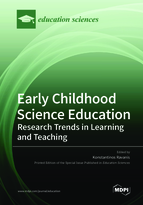Early Childhood Science Education: Research Trends in Learning and Teaching
A special issue of Education Sciences (ISSN 2227-7102). This special issue belongs to the section "Curriculum and Instruction".
Deadline for manuscript submissions: closed (15 January 2022) | Viewed by 63369
Special Issue Editor
Interests: early childhood science education; physics education; preschool education; ICT education
Special Issues, Collections and Topics in MDPI journals
Special Issue Information
Dear Colleagues,
Over the last 50 years, early childhood education in relation to the concepts of the physical and biological sciences has gained importance in different scientific and epistemological contexts. Trends in pedagogy and psychology oriented towards learning, and specifically science education, both on the research and implementation levels, have focused on the conditions that encourage children aged 4–8 years to come into contact with the world of physical and biological sciences. In this perspective, a diverse and dynamic theoretical and research current has emerged, which is often recognized as “early childhood science education”.
This Special Issue of Education Sciences aims to reflect contemporary research trends in the field of early childhood science education. Potential topics include the following: mental representations of early childhood, specialized teaching interventions and activities in different theoretical contexts, teacher training, children argumentation and creativity, and student and teacher motivation. Any other topic within the scope of this Special Issue is also welcome and will be fully considered.
Some references related to the topic are as follows:
Fleer, M., Fragkiadaki, G., Rai, P. (2020). Programmatic research in the Conceptual PlayLab: STEM PlayWorld as an educational experiment and as a source of development. Science Education Research and Praxis, 76, 9-23.
Gallegos-Cazares, L., Flores-Camacho, F., & Calderon-Canales, E. (2009). Preschool science learning: The construction of representations and explanations about colour, shadows, light and images. Review of Science, Mathematics and ICT Education, 3(1), 49-73.
Kambouri, M. (2015). Children's preconceptions of science: Ηow these can be used in teaching. The Journal of Early Years Educator, 16(11), 38-44.
Kamii, C., & Lee-Katz, L. (1982). Physics in preschool education: A Piagetian approach. In J. G. Brown (Ed.), Curriculum planning for young children (pp. 171-176). Washington, DC: National Association for the Education of Young Children.
Mantzicopoulos P, Patrick H & Samarapungavan A 2013. Science literacy in school and home contexts: Kindergarteners’ Science achievement and motivation. Cognition and Instruction, 31(1), 62-119.
Ravanis, K. (2017). Early Childhood Science Education: state of the art and perspectives. Journal of Baltic Science Education, 16(3), 284-288.
Trundle, K. C. (2010). Teaching science during the early childhood years. Best practices and research base. National Geographic learning. Retrieved from https://ngl.cengage.com/assets/downloads/ngsci_pro0000000028/am_trundle_teach_sci_early_child_scl22-0429a.pdf.
Dr. Konstantinos Ravanis
Guest Editor
Manuscript Submission Information
Manuscripts should be submitted online at www.mdpi.com by registering and logging in to this website. Once you are registered, click here to go to the submission form. Manuscripts can be submitted until the deadline. All submissions that pass pre-check are peer-reviewed. Accepted papers will be published continuously in the journal (as soon as accepted) and will be listed together on the special issue website. Research articles, review articles as well as short communications are invited. For planned papers, a title and short abstract (about 100 words) can be sent to the Editorial Office for announcement on this website.
Submitted manuscripts should not have been published previously, nor be under consideration for publication elsewhere (except conference proceedings papers). All manuscripts are thoroughly refereed through a double-blind peer-review process. A guide for authors and other relevant information for submission of manuscripts is available on the Instructions for Authors page. Education Sciences is an international peer-reviewed open access monthly journal published by MDPI.
Please visit the Instructions for Authors page before submitting a manuscript. The Article Processing Charge (APC) for publication in this open access journal is 1800 CHF (Swiss Francs). Submitted papers should be well formatted and use good English. Authors may use MDPI's English editing service prior to publication or during author revisions.
Keywords
- early childhood science education
- mental representations of early childhood children
- teaching interventions and activities
- teacher training
- children argumentation and creativity






